
|
 |

|
 |
Contemporary Nayikas: An innovative approach - Shruti Patki e-mail: shruti.patki@gmail.com December 19, 2015 (This article has been published in the biweekly magazine 'Loud Applause' which is an initiative by Kathak Pathshala of Neha Muthiyan) When we ask dancers why they dance, we get to know many perspectives. Some say they do so for their happiness and peace; some do so as it is their first love; and some consider it as a pathway to connect with the Divine. Speaking for myself, I find it important to connect with my audience; but most importantly, to connect with my students while teaching them. Recently while teaching Bharata's Nayika descriptions to my students, I realised that they had a very different mindset about the whole situation the Nayika was in. While the traditional Virahotkanthita was engrossed in great sorrow due to the separation from her Nayaka, my students felt that she should develop her own life/career and a circle of friends rather than mourning over the estrangement. After giving it a fair thought myself, I too came to the conclusion that maybe new areas of abhinaya need to be explored. Traditional abhinaya compositions and Indian mythology are an inseparable element of all Indian classical dance styles. One cannot differentiate Krishna or Shiva from dance, both being described as being proficient dancers. Since the origin of all Indian classical dance styles lies either in the ritualistic worship of Indian deities or in reciting/acting out different plots from ancient Indian epics (Mahabharata, Ramayana etc.) it is very clear that these are the roots of these dances. Now that these roots are so firmly and deeply ingrained into our hearts, can this beautiful tree be allowed to flower and thus reproduce offspring which may be allowed to explore any more concepts retaining this traditional aspect? Indian arts indeed have a lot to offer to the world. But shouldn't Indian artists (classical dancers specifically) think about the next generation that is growing up in our country? For our art to blossom and flourish in the changing societal scenarios, shouldn't we be vigilantly responsible for educating the audience of the next generation, who is watching Little Krishna, Chota Bheem and Bal Hanuman on their TVs sitting at home? We have many examples of Gurus experimenting and succeeding with classical styles. Pt. Durga Lal introduced the concepts of "Bhav Paran" and "Bhav Aamad" so as to add the involvement of the audience in the performance. Pt. Birju Maharaj ji gave birth to the Ginti (a bandish comprising of numbers 1 to 9 used by one and all in day to day life ) so that even a common man could appreciate the intense "laykari." Dancer and choreographer Mallika Sarabhai has written, choreographed and created many art works which reflect current issues and awareness among people (Shakti - The Power of Women, Unsuni - Unheard Voices etc). As legendary Guru Kelucharan Mohapatra puts it, "The real dance must convey the feeling of undivided existence, that a spectator can feel that he is not different from the thing observed." Thus, with all these examples in front of us, shouldn't we be the ones to think about how to connect with our audience through our art? Not only today, but also 40 years down the line from now? Let us not forget that our students too are a part of our audience, their peer group included. Their connection with our performance as also with their learning material is of exceptional importance. It is our duty to ensure the propagation of our dance style, for we owe it to our art. Having this notion in mind and constantly pondering over the subject, a unique concept struck my mind. That was when the Nayika "ANAMIKA" was born. ANAMIKA 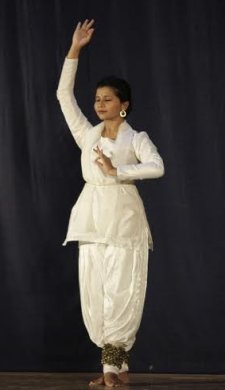 Anamika mudra 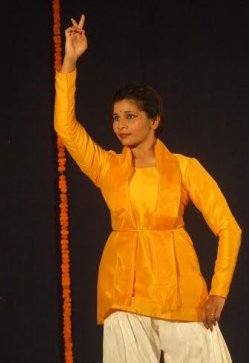 Agnishikha mudra 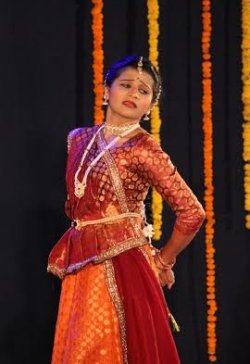 Bandini mudra This Nayika is the cardinal Nayika; the supreme, the fundamental, the principal focus. A fraction of her dwells in every woman, however in a latent state. We can say that her presence is not known to all women. She may or may not reveal her presence. Whether she does or does not reveal herself depends on the occurrences or incidents in the particular woman's life. When facing a difficult situation or while going through tough times, Anamika unveils herself and the woman too takes cognizance of her presence. Anamika is that element in every woman which tells her to hold on; that tells her to keep going, no matter what; that gives her the motivation she needs but may not be getting from outside; it is a positive source of energy that resides in her core self. While the Anamika inspires and encourages women, she does not lay down the course of actions that her bearer should follow. Her job is only to stimulate thinking and awareness and to galvanize her carrier into acting in her (the carrier's) best interests. However, not all women are strong enough to accept the helping hand extended by Anamika. This categorises women into two categories: 1. Agnishikha: Like a burning flame, the Agnishikha is the Nayika who is dynamic, ardent and impregnable. She can sometimes get dejected and may fall apart. But she does take due help of the Anamika in her and thus becomes resilient again. She overcomes her hard times and learns from every predicament. She avoids repeating her mistakes of the past. Moreover, the Agnishikha becomes more fierce as the Anamika in her thrives prosperously. 2. Bandini: As the name suggests, the Bandini is timorous, meek and dithering. Though she duly realises the calls of the Anamika inside her, she is afraid to listen to them. She keeps on believing what external elements impose upon her and this often results in her being incapacitated. She is easily manipulated and wishes to transform herself into the Agnishikha. The Agnishikha and the Bandini are both forms of the Nayika which are not permanent. Certain situations may demand the Bandini to convert herself into the Agnishikha and vice versa. This transformation is solely based on the situation. After explaining the main categories of Nayikas, let us proceed to knowing the general Nayika classifications. BASED ON CAREER CHOICES 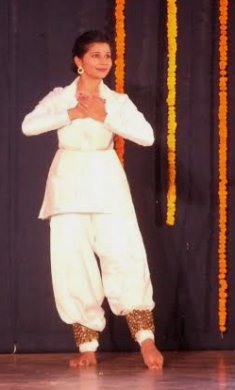 Vyavaswayi mudra 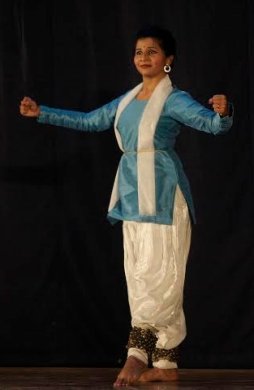 Samanvita mudra 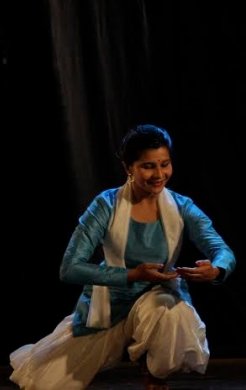 Gruhini mudra Vyavaswayi: The career oriented I am proud, independent and fearless... A woman of principles. Being emotionally strong, I reach my goal... No matter how many the obstacles! None can pull me down, no matter how hard they try. Coz without looking back, I keep moving ahead... Always with my head held high. Samanvita: The one who strikes a balance between her career and family With my family on one hand and aims on the other With balance is how I like to walk on the path of life. While enjoying the best of both worlds on my plate It is often that I find myself in a strife. Gruhini: The homemaker My family is my life and my life is my family It is with my whole heart that I tend to them My aim is to be a successful homemaker Coz my family is as precious as any gem The Vyavaswayi may be married or she may choose to remain unmarried as well. The Samanvita and Gruhini can further be divided into two categories - the ones who choose to do so and the ones who are compelled to do so. The above writings depict the ones who choose to be the Samanvita or the Gruhini. BASED ON PROCREATION Prajananya: The one who can beget children The Prajananya is the Nayika who can beget children. Whether she does or not is completely her vote. Vandhya: The one who is unable to bear children The Vandhya is the Nayika who is infertile and thus unable to bear children. BASED ON BEHAVIOURAL CHARACTERISTICS Prerita: The one who motivates and encourages The Prerita is the one who spreads positive energy wherever she goes. She has a very enthusiastic aura about herself and thus is reassuring and pragmatic towards all the individuals she meets. She carries herself with confidence and greets everyone with great joy making them feeling welcome. She might have got her characteristics due to the experiences that she has had to deal with in the past. Paravrutta: The one who is woeful The Paravrutta is the Nayika who is depressed and despondent. She carries a gloomy aura around herself. The Paravrutta is such engrossed in her own sorrow that she finds it hard to let it go. She converts her melancholy into her comfort zone thus disseminating a negative vibe wherever she goes. The Prerita and Paravrutta are not permanent forms. A Prerita can eventually turn into a Paravrutta (it happens very rarely) and a Paravrutta can transform herself into the Prerita with due efforts and cognizance. This subject of Nayikas is indeed very vast. I have been working on it and have come up with a few more Nayikas. It can be noted that it is hard to classify each and every woman into one of the above categories. However, every woman can be categorised into Bandini or Agnishikha. There are different kinds of Nayikas all around us. We meet them every day. We women are all Nayikas and we all may fall into various categories. Every category does exist and every characteristic that makes us who we are may define a different Nayika every day. Thus, every woman is a self defined Nayika in herself! Shruti Patki is a student of Maneesha Sathe and Shambhavi Dandekar. She was awarded the "Lt. Pt. Lachchu Maharaj Award" at Prerna Foundation's State Level Competition for securing first place in Kathak in the Senior Group (2010, Pune). She is a Gold Medalist of Kathak (M.A. 2014) from Lalit Kala Kendra, Pune University. Post your comments Please provide your name and email id when you use the Anonymous profile in the blog to post a comment. All appropriate comments posted with name & email id in the blog will also be featured in the site. |